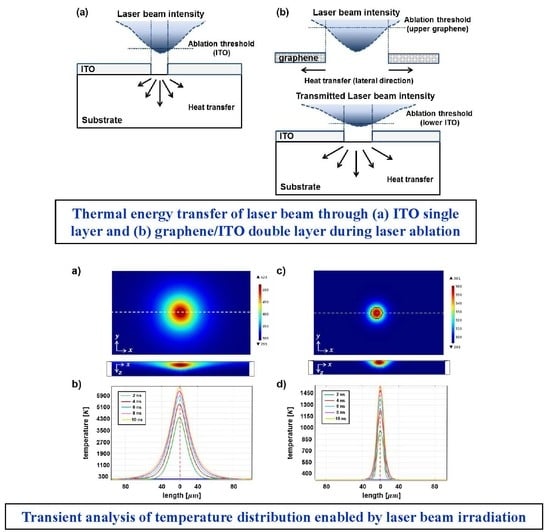Understanding of the Mechanism for Laser Ablation-Assisted Patterning of Graphene/ITO Double Layers: Role of Effective Thermal Energy Transfer
Abstract
1. Introduction
2. Materials and Methods
3. Results and Discussion
4. Conclusions
Supplementary Materials
Author Contributions
Funding
Conflicts of Interest
References
- Hamberg, I.; Granqvist, C.G. Evaporated Sn-doped In2O3 films: Basic optical properties and applications to energy-efficient windows. J. Appl. Phys. 1986, 60, R123–R160. [Google Scholar] [CrossRef]
- Kobayashi, H.; Ishida, T.; Nakato, Y.; Tsubomura, H. Mechanism of carrier transport in highly efficient solar cells having indium tin oxide/Si junctions. J. Appl. Phys. 1991, 69, 1736–1743. [Google Scholar] [CrossRef]
- Lee, B.H.; Kim, I.G.; Cho, S.W.; Lee, S.-H. Effect of process parameters on the characteristics of indium tin oxide thin film for flat panel display application. Thin Solid Films 1997, 302, 25–30. [Google Scholar] [CrossRef]
- Park, Y.-S.; Park, H.-K.; Jeong, J.-A.; Kim, H.-K.; Choi, K.-H.; Na, S.-I.; Kim, D.-Y. Comparative Investigation of Transparent ITO/Ag/ITO and ITO/Cu/ITO Electrodes Grown by Dual-Target DC Sputtering for Organic Photovoltaics. J. Electrochem. Soc. 2009, 156, H588–H594. [Google Scholar] [CrossRef]
- Park, H.-K.; Kang, J.-W.; Na, S.-I.; Kim, D.-Y.; Kim, H.-K. Characteristics of indium-free GZO/Ag/GZO and AZO/Ag/AZO multilayer electrode grown by dual target DC sputtering at room temperature for low-cost organic photovoltaics. Sol. Energy Mater. Sol. Cells 2009, 93, 1994–2002. [Google Scholar] [CrossRef]
- Liu, Y.; Zhang, J.; Gao, H.; Wang, Y.; Liu, Q.; Huang, S.; Guo, C.F.; Ren, Z. Capillary-Force-Induced Cold Welding in Silver-Nanowire-Based Flexible Transparent Electrodes. Nano Lett. 2017, 17, 1090–1096. [Google Scholar] [CrossRef]
- Ge, Y.; Duan, X.; Zhang, M.; Mei, L.; Hu, J.; Hu, W.; Duan, X. Direct Room Temperature Welding and Chemical Protection of Silver Nanowire Thin Films for High Performance Transparent Conductors. J. Am. Chem. Soc. 2018, 140, 193–199. [Google Scholar] [CrossRef]
- Hsu, W.-J.; Ibrahim, I.A.M.; Lin, Y.-H.; Yang, Z.-H.; Yucelen, G.I.; Han, J.W.; Kang, D.-Y. Transparent Conductive Films Derived from Single-Walled Aluminosilicate Nanotubes. ACS Appl. Nano Mater. 2019, 2, 6677–6689. [Google Scholar] [CrossRef]
- Tang, H.; Feng, H.; Wang, H.; Wan, X.; Liang, J.; Chen, Y. Highly Conducting MXene–Silver Nanowire Transparent Electrodes for Flexible Organic Solar Cells. ACS Appl. Mater. Interfaces 2019, 11, 25330–25337. [Google Scholar] [CrossRef]
- Su, D.-Y.; Hsu, C.-C.; Lai, W.-H.; Tsai, F.-Y. Fabrication, Mechanisms, and Properties of High-Performance Flexible Transparent Conductive Gas-Barrier Films Based on Ag Nanowires and Atomic Layer Deposition. ACS Appl. Mater. Interfaces 2019, 11, 34212–34221. [Google Scholar] [CrossRef]
- Dai, Q.; Rajasekharan, R.; Butt, H.; Qiu, X.; Amaragtunga, G.; Wilkinson, T.D. Ultrasmall Microlens Array Based on Vertically Aligned Carbon Nanofibers. Small 2012, 8, 2501–2504. [Google Scholar] [CrossRef]
- Alonso, E.T.; Karkera, G.; Jones, G.F.; Craciun, M.F.; Russo, S. Homogeneously Bright, Flexible, and Foldable Lighting Devices with Functionalized Graphene Electrodes. ACS Appl. Mater. Interfaces 2016, 8, 16541–16545. [Google Scholar] [CrossRef] [PubMed]
- Dou, L.; Cui, F.; Yu, Y.; Khanarian, G.; Eaton, S.W.; Yang, Q.; Resasco, J.; Schildknecht, C.; Schierle-Arndt, K.; Yang, P. Solution-Processed Copper/Reduced-Graphene-Oxide Core/Shell Nanowire Transparent Conductors. ACS Nano 2016, 10, 2600–2606. [Google Scholar] [CrossRef] [PubMed]
- Peng, H.; Zhong, Y.; Zhang, X.; He, Y.; Wang, G. Percolating Film of Pillared Graphene Layer Integrated with Silver Nanowire Network for Transparent and Flexible Supercapacitors. Langmuir 2018, 34, 15245–15252. [Google Scholar] [CrossRef] [PubMed]
- Novoselov, K.; Geim, A.K.; Morozov, S.; Jiang, D.; Zhang, Y.; Dubonos, S.V.; Grigorieva, I.V.; Firsov, A.A. Electric Field Effect in Atomically Thin Carbon Films. Science 2004, 306, 666–669. [Google Scholar] [CrossRef] [PubMed]
- Bonaccorso, F.; Sun, Z.; Hasan, T.; Ferrari, A.C. Graphene photonics and optoelectronics. Nat. Photonics 2010, 4, 611–622. [Google Scholar] [CrossRef]
- Kim, K.S.; Zhao, Y.; Jang, H.; Lee, S.Y.; Kim, J.M.; Kim, K.S.; Ahn, J.-H.; Kim, P.; Choi, J.-Y.; Hong, B.H. Large-scale pattern growth of graphene films for stretchable transparent electrodes. Nature 2009, 457, 706–710. [Google Scholar] [CrossRef]
- Schedin, F.; Geim, A.K.; Morozov, S.V.; Hill, E.H.; Blake, P.; Katsnelson, M.I.; Novoselov, K.S. Detection of individual gas molecules adsorbed on graphene. Nat. Mater. 2007, 6, 652–655. [Google Scholar] [CrossRef]
- Berger, C.; Song, Z.; Li, X.; Wu, X.; Brown, N.; Naud, C.; Mayou, D.; Hass, J.; Marchenkov, A.N.; Conrad, E.H.; et al. Electronic Confinement and Coherence in Patterned Epitaxial Graphene. Science 2006, 312, 1191–1196. [Google Scholar] [CrossRef]
- Zhang, M.; Wang, X.; Cao, W.; Yuan, J.; Cao, M. Electromagnetic Functions of Patterned 2D Materials for Micro–Nano Devices Covering GHz, THz, and Optical Frequency. Adv. Opt. Mater. 2019, 7, 1900689. [Google Scholar] [CrossRef]
- Takai, M.; Bollmann, D.; Haberger, K. Maskless patterning of indium tin oxide layer for flat panel displays by diode-pumped Nd:YLF laser irradiation. Appl. Phys. Lett. 1994, 64, 2560–2562. [Google Scholar] [CrossRef]
- Chen, M.-F.; Chen, Y.-P.; Hsiao, W.-T.; Gu, Z.-P. Laser direct write patterning technique of indium tin oxide film. Thin Solid Films 2007, 515, 8515–8518. [Google Scholar] [CrossRef]
- Liu, Z.-B.; Li, L.; Xu, Y.-F.; Liang, J.-J.; Zhao, X.; Chen, S.-Q.; Chen, Y.-S.; Tian, J.-G. Direct patterning on reduced graphene oxide nanosheets using femtosecond laser pulses. J. Opt. 2011, 13, 085601. [Google Scholar] [CrossRef]
- Kalita, G.; Qi, L.; Namba, Y.; Wakita, K.; Umeno, M. Femtosecond laser induced micropatterning of graphene film. Mater. Lett. 2011, 65, 1569–1572. [Google Scholar] [CrossRef]
- Yoo, J.-H.; Bin In, J.; Park, J.B.; Jeon, H.; Grigoropoulos, C.P. Graphene folds by femtosecond laser ablation. Appl. Phys. Lett. 2012, 100, 233124. [Google Scholar] [CrossRef]
- Şahin, R.; Simsek, E.; Akturk, S. Nanoscale patterning of graphene through femtosecond laser ablation. Appl. Phys. Lett. 2014, 104, 53118. [Google Scholar] [CrossRef]
- Zhou, Y.; Bao, Q.; Tang, L.A.L.; Zhong, Y.L.; Loh, K.P. Hydrothermal Dehydration for the “Green” Reduction of Exfoliated Graphene Oxide to Graphene and Demonstration of Tunable Optical Limiting Properties. Chem. Mater. 2009, 21, 2950–2956. [Google Scholar] [CrossRef]
- Reina, A.; Jia, X.; Ho, J.; Nezich, D.; Son, H.; Bulović, V.; Dresselhaus, M.S.; Kong, J. Large Area, Few-Layer Graphene Films on Arbitrary Substrates by Chemical Vapor Deposition. Nano Lett. 2009, 9, 30–35. [Google Scholar] [CrossRef]
- Kang, S.; Yoon, T.; Kim, S.; Kim, T.-S. Role of Crack Deflection on Rate Dependent Mechanical Transfer of Multilayer Graphene and Its Application to Transparent Electrodes. ACS Appl. Nano Mater. 2019, 2, 1980–1985. [Google Scholar] [CrossRef]
- Li, X.; Zhu, Y.; Cai, W.; Borysiak, M.; Han, B.; Chen, D.; Piner, R.D.; Colombo, L.; Ruoff, R.S. Transfer of Large-Area Graphene Films for High-Performance Transparent Conductive Electrodes. Nano Lett. 2009, 9, 4359–4363. [Google Scholar] [CrossRef]
- Mattevi, C.; Kim, H.; Chhowalla, M. A review of chemical vapour deposition of graphene on copper. J. Mater. Chem. 2011, 21, 3324–3334. [Google Scholar] [CrossRef]
- Kim, I.H.; Kim, D.; Yin, M.Y.; Han, J.-H.; Kwon, S.J.; Cho, E.-S. Characteristics of graphene embedded indium tin oxide (ITO-graphene-ITO) transparent conductive films. Mol. Cryst. Liq. Cryst. 2018, 676, 95–104. [Google Scholar] [CrossRef]
- Liu, J.M. Simple technique for measurements of pulsed Gaussian-beam spot sizes. Opt. Lett. 1982, 7, 196–198. [Google Scholar] [CrossRef] [PubMed]
- Bonse, J.; Wrobel, J.; Krüger, J.; Kautek, W. Ultrashort-pulse laser ablation of indium phosphide in air. Appl. Phys. A 2001, 72, 89–94. [Google Scholar] [CrossRef]
- Račiukaitis, G.; Brikas, M.; Gedvilas, M.; Rakickas, T. Patterning of indium–tin oxide on glass with picosecond lasers. Appl. Surf. Sci. 2007, 253, 6570–6574. [Google Scholar] [CrossRef]
- Xiao, S.; Fernandes, S.A.; Ostendorf, A. Selective Patterning of ITO on flexible PET Substrate by 1064nm picosecond Laser. Phys. Procedia 2011, 12, 125–132. [Google Scholar] [CrossRef]
- Rung, S.; Christiansen, A.; Hellmann, R. Influence of film thickness on laser ablation threshold of transparent conducting oxide thin-films. Appl. Surf. Sci. 2014, 305, 347–351. [Google Scholar] [CrossRef]
- Wang, R. Laser Ablation of Graphene–Fundamental Processes and Applications. Master’s Thesis, Department of Mechanical Engineering, University of California at Berkeley, Berkeley, CA, USA, 2013. [Google Scholar]
- Wang, J.-X.; Kwon, S.J.; Han, J.-H.; Cho, E.S. Nd:YVO4 laser direct ablation of indium tin oxide films deposited on glass and polyethylene terephthalate substrates. J. Nanosci. Nanotechnol. 2013, 13, 6280–6285. [Google Scholar] [CrossRef]
- Lee, J.M.; Lee, J.-H.; Han, J.-H.; Yoo, J.-B.; Lee, J.-H.; Cho, S.; Kwon, S.J.; Cho, E.S. Nd:YVO4laser ablation of graphene films on glass and poly(ethylene terephthalate) substrates. Jpn. J. Appl. Phys. 2014, 53, 08NL02. [Google Scholar] [CrossRef][Green Version]
- Li, Z.H.; Cho, E.S.; Kwon, S.J. A new laser direct etching method of indium tin oxide electrode for application to alternative current plasma display panel. Appl. Surf. Sci. 2009, 255, 9843–9846. [Google Scholar] [CrossRef]
- Tseng, S.-F.; Hsiao, W.-T.; Huang, K.-C.; Chiang, D. The effect of laser patterning parameters on fluorine-doped tin oxide films deposited on glass substrates. Appl. Surf. Sci. 2011, 257, 8813–8819. [Google Scholar] [CrossRef]
- Balandin, A.A.; Ghosh, S.; Bao, W.; Calizo, I.; Teweldebrhan, D.; Miao, F.; Lau, C.N. Superior Thermal Conductivity of Single-Layer Graphene. Nano Lett. 2008, 8, 902–907. [Google Scholar] [CrossRef] [PubMed]
- Han, G.H.; Chae, S.J.; Kim, E.S.; Güneş, F.; Lee, I.H.; Lee, S.W.; Lee, S.Y.; Lim, S.C.; Jeong, H.K.; Jeong, M.S.; et al. Laser Thinning for Monolayer Graphene Formation: Heat Sink and Interference Effect. ACS Nano 2010, 5, 263–268. [Google Scholar] [CrossRef] [PubMed]
- Bulgakova, N.; Bulgakov, A.V.; Babich, L. Energy balance of pulsed laser ablation: Thermal model revised. Appl. Phys. A 2004, 79, 1323–1326. [Google Scholar] [CrossRef]
- Bovatsek, J.; Tamhankar, A.; Patel, R.; Bulgakova, N.; Bonse, J. Thin film removal mechanisms in ns-laser processing of photovoltaic materials. Thin Solid Films 2010, 518, 2897–2904. [Google Scholar] [CrossRef]
- Park, G.; Lee, J.; Kang, S.; Kim, M.; Kang, S.; Choi, W. Design principle of super resolution near-field structure using thermally responsive optical phase change materials for nanolithography applications. Mater. Des. 2016, 102, 45–55. [Google Scholar] [CrossRef]
- Record of Polyethylene Terephthalate in the GESTIS Substance Database of the Institute for Occupational Safety and Health. Available online: http://www.dguv.de/ifa/gestis-database (accessed on 7 November 2007).
- Van der Vegt, A.K.; Govaert, L.E. Polymeren: Van Keten Tot Kunstof; VSSD: Delft, The Netherlands, 2005; ISBN 9071301486. [Google Scholar]
- Dresselhaus, M.; Dresselhaus, G.; Saito, R.; Jorio, A. Raman spectroscopy of carbon nanotubes. Phys. Rep. 2005, 409, 47–99. [Google Scholar] [CrossRef]
- Jung, D.; Park, H.W.; Ma, G.; Lee, C.Y.; Kwon, T.; Han, J.-H. Optimal synthesis of horizontally aligned single-walled carbon nanotubes and their biofunctionalization for biosensing applications. J. Nanomater. 2016, 2016, 5140241. [Google Scholar] [CrossRef]
- Tran, T.S.; Park, S.J.; Yoo, S.S.; Lee, T.-R.; Kim, T. High shear-induced exfoliation of graphite into high quality graphene by Taylor–Couette flow. RSC Adv. 2016, 6, 12003. [Google Scholar] [CrossRef]
- Jung, S.; Myung, Y.; Kim, B.N.; Kim, I.G.; You, I.-K.; Kim, T. Activated biomass-derived graphene-based carbons for supercapacitors with high energy and power density. Sci. Rep. 2018, 8, 1915. [Google Scholar] [CrossRef]
- Nguyen, D.K.; Kim, T. Graphene quantum dots produced by exfoliation of intercalated graphite nanoparticles and their application for temperature sensors. Appl. Surf. Sci. 2018, 427, 1152–1157. [Google Scholar] [CrossRef]
- Tripathi, K.M.; Kim, T.; Losic, D.; Tung, T.T. Recent advances in engineered graphene and composites for detection of volatile organic compounds (VOCs) and non-invasive diseases diagnosis. Carbon 2016, 110, 97–129. [Google Scholar] [CrossRef]
- Kim, D.; Jung, D.; Noh, J.K.; Han, J.-H. Graphene chemocapacitive sensors for dimethyl methylphosphonate detection. Sci. Adv. Mater. 2018, 10, 1268–1273. [Google Scholar] [CrossRef]
- Myung, Y.; Jung, S.; Tung, T.T.; Tripathi, K.M.; Kim, T. Graphene-based aerogels derived from biomass for energy storage and environmental remediation. ACS Sustain. Chem. Eng. 2019, 7, 3772–3782. [Google Scholar] [CrossRef]
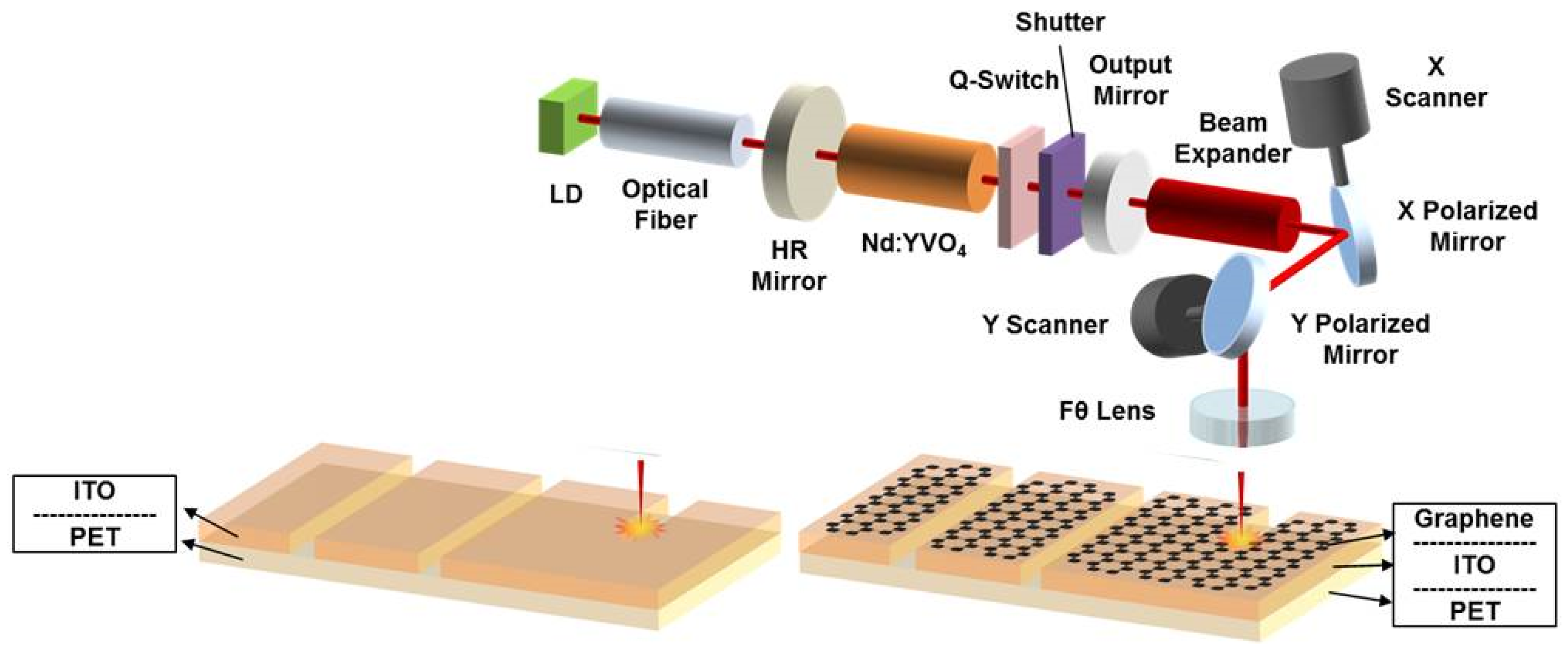

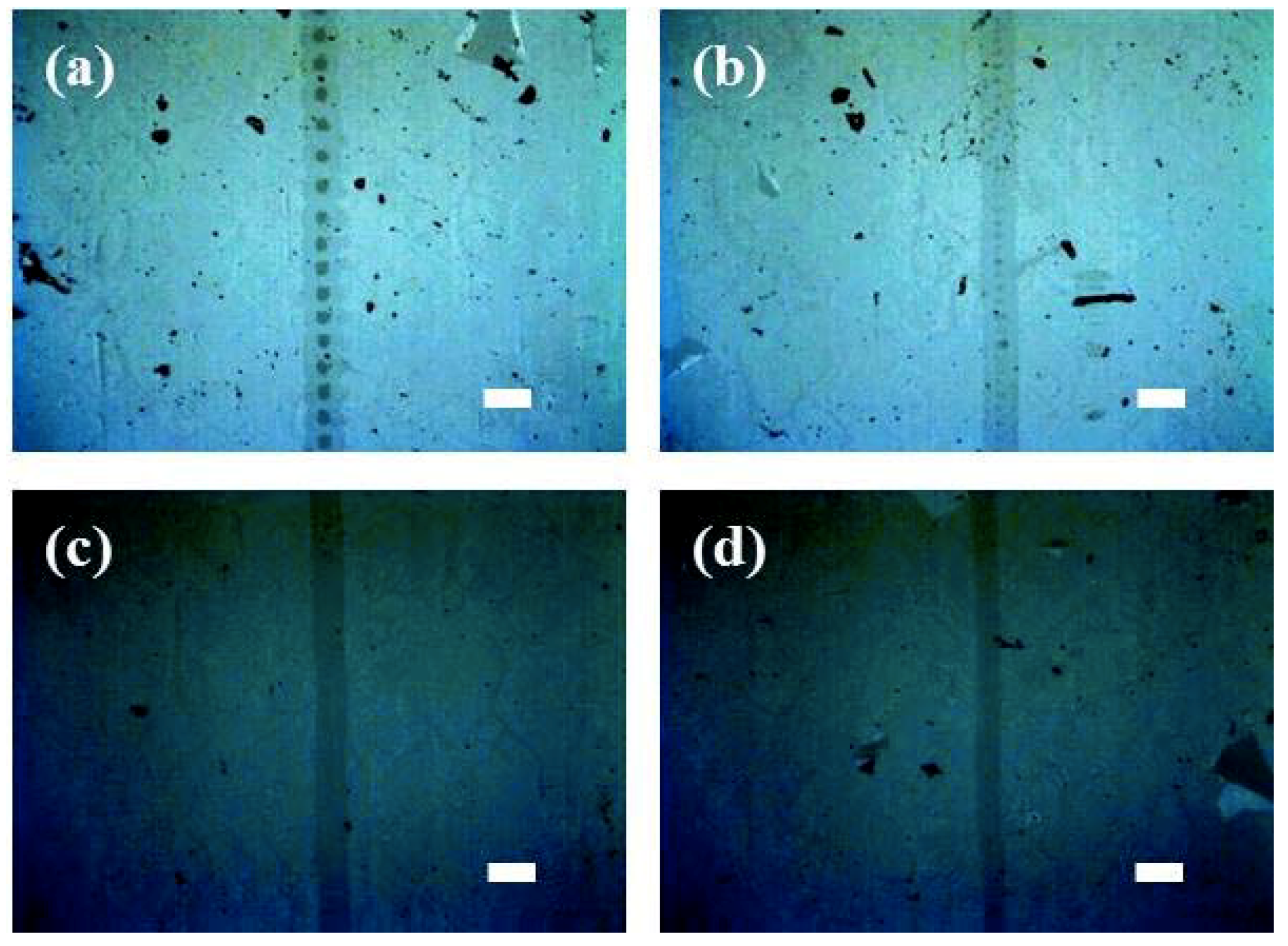
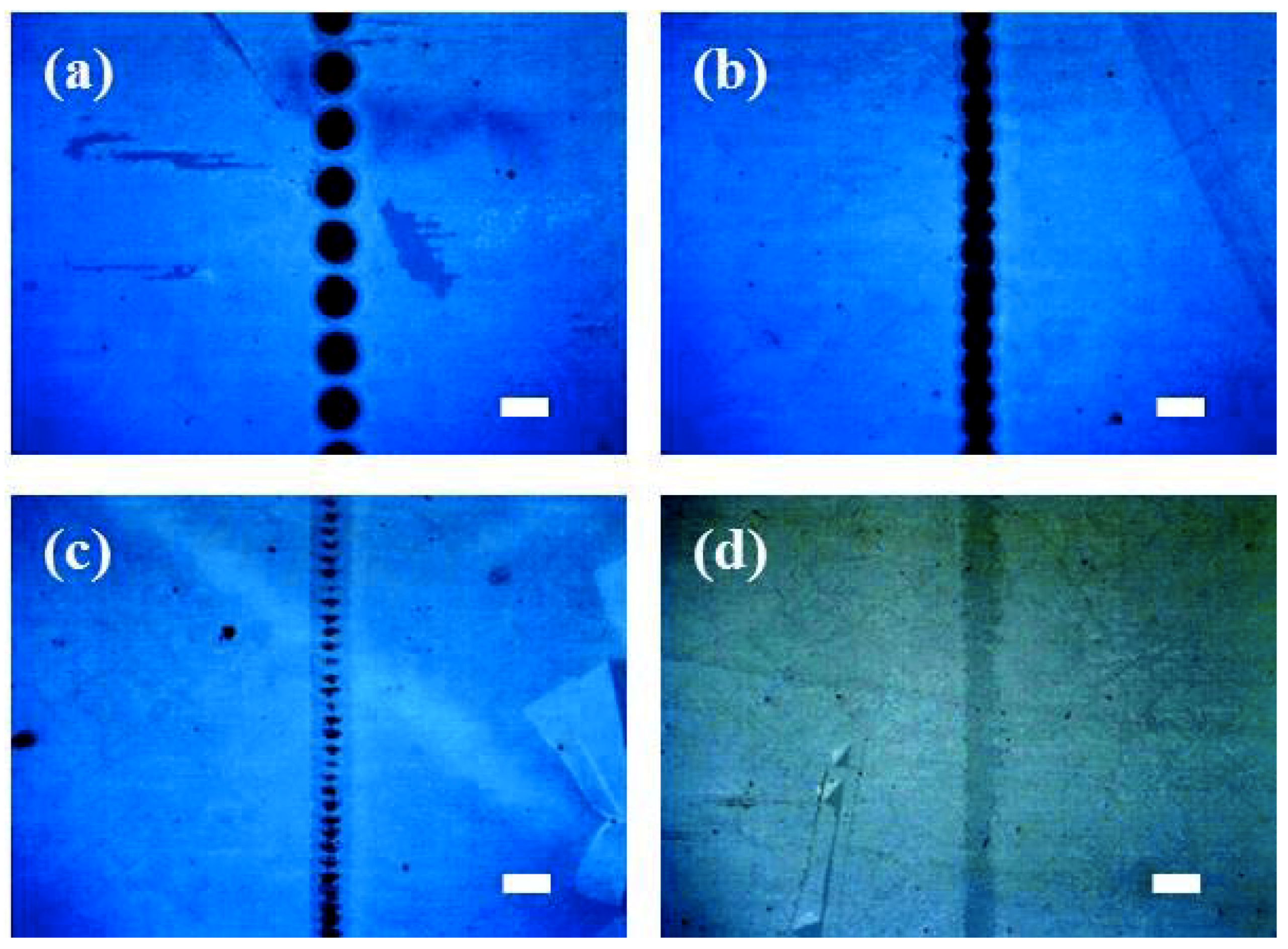


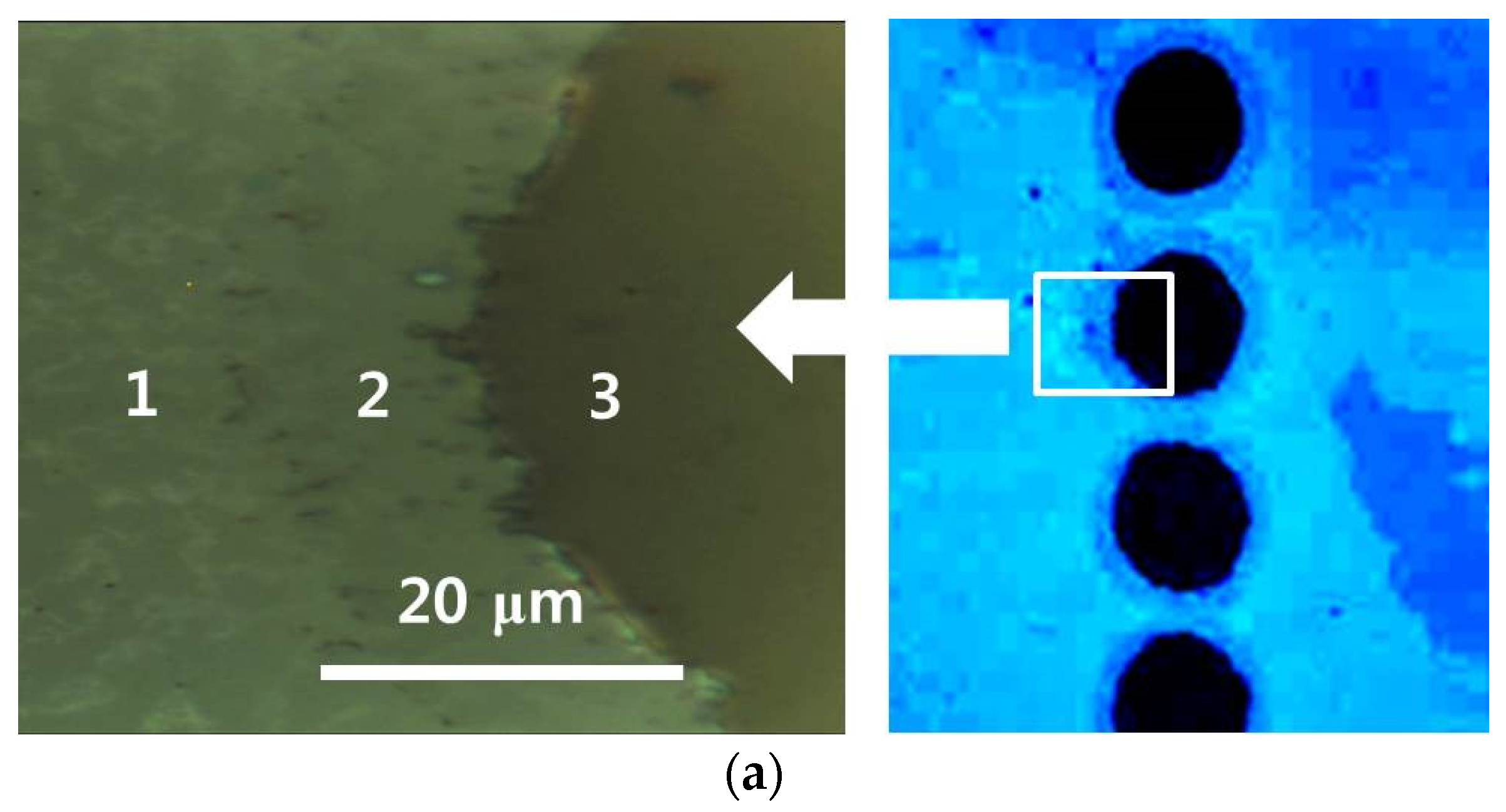
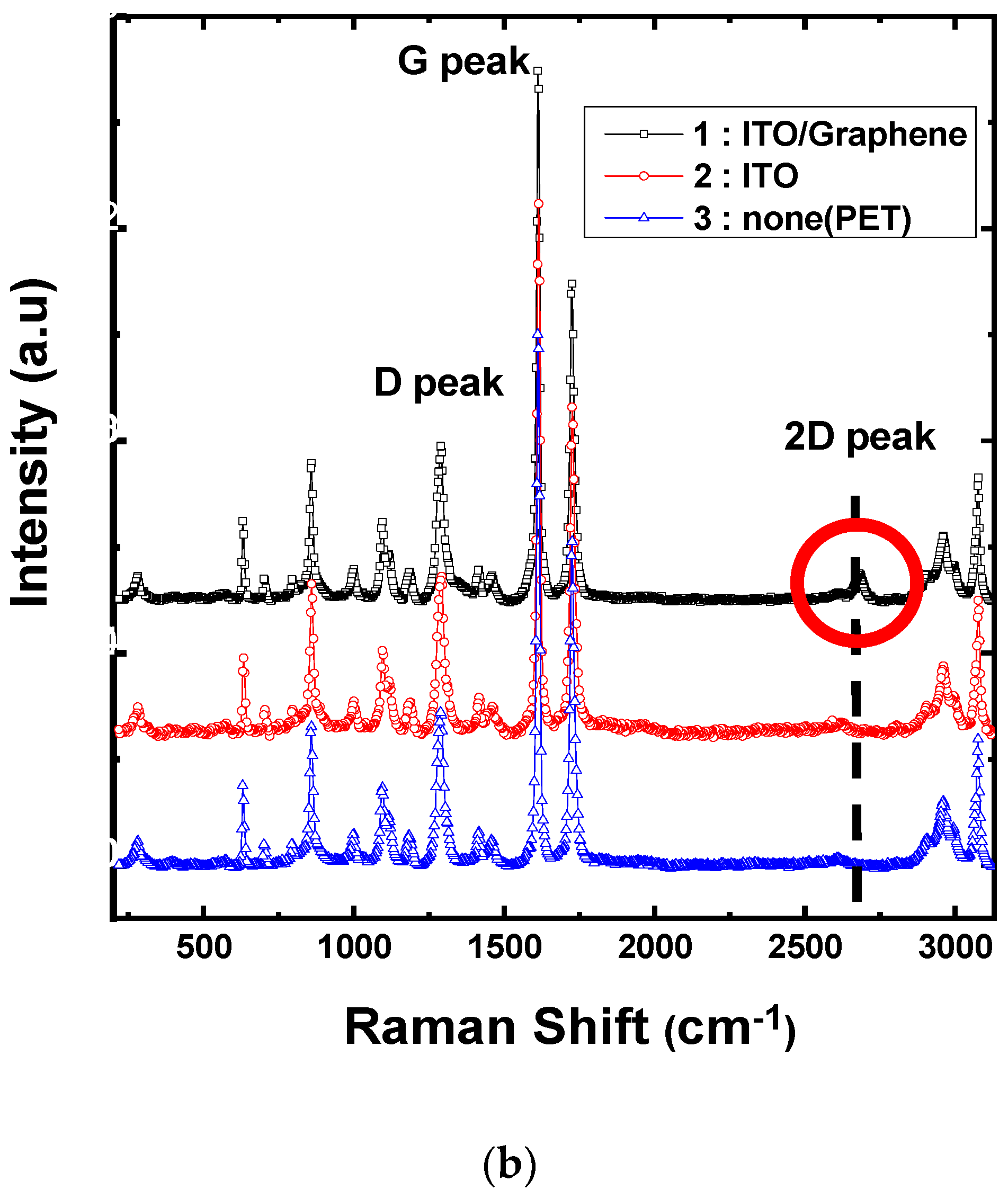
© 2020 by the authors. Licensee MDPI, Basel, Switzerland. This article is an open access article distributed under the terms and conditions of the Creative Commons Attribution (CC BY) license (http://creativecommons.org/licenses/by/4.0/).
Share and Cite
Ryu, H.S.; Kim, H.-S.; Kim, D.; Lee, S.J.; Choi, W.; Kwon, S.J.; Han, J.-H.; Cho, E.-S. Understanding of the Mechanism for Laser Ablation-Assisted Patterning of Graphene/ITO Double Layers: Role of Effective Thermal Energy Transfer. Micromachines 2020, 11, 821. https://doi.org/10.3390/mi11090821
Ryu HS, Kim H-S, Kim D, Lee SJ, Choi W, Kwon SJ, Han J-H, Cho E-S. Understanding of the Mechanism for Laser Ablation-Assisted Patterning of Graphene/ITO Double Layers: Role of Effective Thermal Energy Transfer. Micromachines. 2020; 11(9):821. https://doi.org/10.3390/mi11090821
Chicago/Turabian StyleRyu, Hyung Seok, Hong-Seok Kim, Daeyoon Kim, Sang Jun Lee, Wonjoon Choi, Sang Jik Kwon, Jae-Hee Han, and Eou-Sik Cho. 2020. "Understanding of the Mechanism for Laser Ablation-Assisted Patterning of Graphene/ITO Double Layers: Role of Effective Thermal Energy Transfer" Micromachines 11, no. 9: 821. https://doi.org/10.3390/mi11090821
APA StyleRyu, H. S., Kim, H.-S., Kim, D., Lee, S. J., Choi, W., Kwon, S. J., Han, J.-H., & Cho, E.-S. (2020). Understanding of the Mechanism for Laser Ablation-Assisted Patterning of Graphene/ITO Double Layers: Role of Effective Thermal Energy Transfer. Micromachines, 11(9), 821. https://doi.org/10.3390/mi11090821





